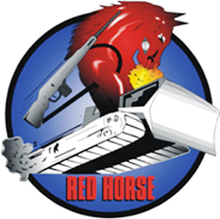|
Rapid Engineer Deployable Heavy Operational Repair Squadron Engineers
   Rapid Engineer Deployable Heavy Operational Repair Squadron Engineer (RED HORSE) squadrons are the United States Air Force's heavy-construction units. Their combat engineering capabilities are similar to those of the U.S. Navy Seabees and U.S. Army heavy-construction organizations.[1] AboutDuring the Vietnam War, Air Force "Prime BEEF" ("PRIMary Base Engineer Emergency Force") teams filled a need for short-term construction capabilities. However, the Air Force needed a stable and longer-term heavy-repair capability. The response was to organize two, 400-man (12 officers and 388 airmen) heavy-repair squadrons.[2] RED HORSE units activated in 1966 when Secretary of Defense Robert McNamara asked the Air Force to develop its own combat construction team.[3] RED HORSE squadrons provide the Air Force with a highly mobile civil engineering response force to support contingency and special operations worldwide. Units are self-sufficient, 404-person mobile squadrons, capable of rapid response and independent operations in remote, high-threat environments worldwide. They provide heavy-repair capability and construction support when requirements exceed normal base civil engineer (Prime BEEF) capabilities and where U.S. Army engineer support is not readily available. RED HORSE units possess personal and crew-served weapons, vehicles, equipment and vehicle maintenance, food service, emergency management (to include CBRN passive defense and Counter-WMD operations), comptroller, contracting, supply and medical equipment and personnel. RED HORSE's major wartime responsibility is to provide a highly mobile, rapidly deployable, civil engineering response force that is self-sufficient to perform heavy damage repair required for recovery of critical Air Force facilities and utility systems, and aircraft launch and recovery. In addition, it accomplishes engineer support for beddown of weapon systems required to initiate and sustain operations in an austere bare-base environment, including remote hostile locations, or locations in a chemical, biological, radiological, and nuclear (CBRN) -prone environment.[citation needed] The primary RED HORSE tasking in peacetime is to train for contingency and wartime operations. It participates regularly in Joint Chiefs of Staff and major command exercises, military operations other than war, and civic action programs. RED HORSE performs training projects that assist base construction efforts while, at the same time, honing wartime skills. Air Force RED HORSE units possess special capabilities, such as water-well drilling, explosive demolition, aircraft arresting system installation, quarry operations, concrete mobile operations, material testing, expedient facility erection, and concrete and asphalt paving.[citation needed] To support the "Open the Airbase" mission, RED HORSE added an Airborne capability in 2003. With this capability, RED HORSE can rapidly deliver small specialized teams and equipment packages by airdrop or air insertion to conduct expedient airfield repairs. Initially, the only RED HORSE unit to have air-inserted troops was the 823rd RED HORSE, in April 2003 at Baghdad International Airport, however, the 554th established an Airborne capability known as the 554th RHS Assault, Assessment, and Repair Operations (AARO, pronounced "arrow") team to provide an Airborne-inserted rapid airfield seizure and repair capability for the Pacific theater.[4] UnitsThere are four active-duty, 4 Air Force Reserve Command, and five Air National Guard RED HORSE squadrons:[5]
On 26 April 2022, the 823rd RED HORSE Squadron Detachment 1 was inactivated and replaced by the 801st RED HORSE Training Squadron.[7] The 1st Expeditionary RED HORSE Group (inactivated) was in the USCENTCOM area of responsibility (AOR).[8] The 557th Expeditionary RED HORSE Squadron is now located in the USCENTCOM AOR, and is part of the 1st Expeditionary Civil Engineering Group that also consists of one Prime BEEF Squadrons and one RED HORSE Squadron. Air Force Reserve:
Air National Guard:
The Air National Guard squadrons are split units with separate commanders. When mobilized (excluding the 219th and 254th), these units come together as one squadron. See also
References
External links |
||||||||||||||||


